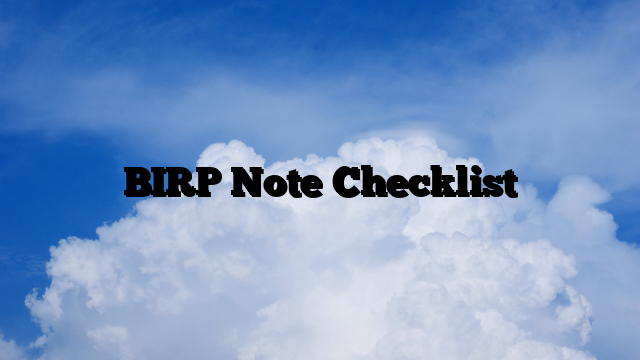In the world of healthcare documentation, BIRP Notes stand as a pivotal tool, offering clarity and structure to the complex tapestry of patient care. BIRP (Behavior, Intervention, Response, and Plan), serves as a comprehensive format that healthcare professionals employ to methodically record and analyze the nuances of patient interactions and treatment progress. The real power of BIRP notes, however, shines through in practical examples that demonstrate their application across diverse scenarios. In this detailed exploration, we delve into a range of BIRP Notes Examples, each illustrating the intricate dance of observation, therapeutic intervention, patient response, and future planning. These examples not only serve as a blueprint for healthcare providers to refine their documentation skills but also offer insights into the multifaceted nature of patient care, highlighting the importance of tailored interventions and the ongoing assessment of treatment strategies. Through these examples, the BIRP format reveals its indispensable role in fostering effective, responsive, and well-documented patient care.
Mental Health BIRP Notes Examples
Here are examples of BIRP notes for different mental health scenarios. These examples are fictional and are intended to provide a sense of how BIRP notes might be structured in various contexts.
Example 1: Anxiety Management
- Behavior: Client reported increased anxiety at work. Exhibited restlessness and was easily startled. Discussed feeling overwhelmed with current project deadlines.
- Intervention: Implemented relaxation techniques, including deep breathing exercises. Discussed time management strategies. Explored underlying fears contributing to anxiety.
- Response: Client engaged well with breathing exercises, reporting a temporary reduction in anxiety levels. Expressed appreciation for time management advice but was hesitant to discuss deeper fears.
- Plan: Continue with relaxation techniques. Next session to focus on cognitive strategies to address anxiety. Assign client to maintain a worry journal.
Example 2: Depression
- Behavior: Client appeared lethargic and reported feelings of sadness and hopelessness. Lack of interest in activities they usually enjoy.
- Intervention: Provided empathetic listening and validation of feelings. Introduced the concept of behavioral activation and planned a simple activity schedule.
- Response: Client was receptive to the ideas but doubted their efficacy. Agreed to try the planned activities reluctantly.
- Plan: Monitor the client’s adherence to the activity schedule. Next session to introduce cognitive restructuring to address negative thought patterns.
Example 3: Relationship Issues
- Behavior: Client expressed frustration and anger regarding recent conflicts with their spouse. Body language was tense, and voice was raised when discussing these issues.
- Intervention: Utilized reflective listening and conflict resolution skills. Guided client through a role-playing exercise to practice effective communication.
- Response: Client showed insight into their communication style and recognized the need for change. Demonstrated a more calm demeanor by the end of the session.
- Plan: Encourage client to apply new communication skills at home. Plan to introduce couple’s therapy as a possible next step.
Example 4: Substance Abuse Recovery
- Behavior: Client shared feelings of temptation to use substances again. Mentioned stress at work as a trigger. Seemed anxious but determined to stay sober.
- Intervention: Reviewed coping strategies for managing cravings. Discussed the client’s support network and how to seek help when needed. Reinforced the progress made so far.
- Response: Client appeared motivated to continue sobriety. Acknowledged that stress was a significant trigger and expressed willingness to use coping strategies.
- Plan: Continue to reinforce coping mechanisms. Encourage attendance at support group meetings. Next session to focus on stress management techniques.
Example 5: Grief Counseling
- Behavior: Client was tearful while discussing the recent loss of a family member. Expressed feelings of guilt and regret. Struggled to talk about positive memories.
- Intervention: Provided a safe space for the client to express emotions. Introduced the concept of the grief process. Guided the client in a memory-sharing exercise.
- Response: Client began to share positive memories by the end of the session, though still exhibited significant sadness and occasional guilt.
- Plan: Continue to support the client in expressing grief. Assign reflective writing about positive memories for the next session. Introduce coping strategies for guilt.
Example 6: Managing ADHD in Adolescence
- Behavior: The adolescent client showed difficulty maintaining focus during the session, frequently changing subjects. Mentioned struggling with school assignments and feeling “restless” most of the time.
- Intervention: Discussed and practiced focus-enhancing strategies like breaking tasks into smaller steps. Introduced a basic organization and planning tool. Provided psychoeducation about ADHD and its impacts.
- Response: The client was interested in the planning tool and willing to try it for schoolwork. Showed understanding of how ADHD affects their daily life but expressed doubts about the efficacy of strategies.
- Plan: Assign the client to use the planning tool for a week and monitor its effectiveness. Plan to discuss time management and further coping strategies in the next session. Consider consulting with parents for a structured home environment.
Example 7: Overcoming Social Anxiety
- Behavior: The client reported feeling extremely nervous about upcoming social events. Described physical symptoms of anxiety such as sweating and trembling in social situations. Avoided eye contact during the session.
- Intervention: Utilized Cognitive-Behavioral Therapy (CBT) techniques to challenge negative thoughts about social interactions. Practiced deep breathing exercises. Role-played social scenarios to build confidence.
- Response: The client actively participated in role-playing exercises, showing gradual improvement in confidence. Reported feeling slightly more at ease with the breathing techniques.
- Plan: Encourage the client to attend a small social gathering before the next session. Continue with role-playing and CBT in upcoming sessions. Assign to practice breathing exercises daily.
Example 8: Coping with Post-Traumatic Stress Disorder (PTSD)
- Behavior: The client was visibly distressed while discussing a past traumatic event. Reported recurring nightmares and flashbacks. Demonstrated hypervigilance and startled easily during the session.
- Intervention: Provided a safe and supportive environment for the client to discuss their trauma at their own pace. Introduced grounding techniques to manage acute distress. Started discussing the basics of trauma-focused therapy.
- Response: The client responded well to grounding techniques, using them to regain composure. Showed willingness to explore trauma-focused therapy but remained apprehensive about discussing detailed aspects of the trauma.
- Plan: Focus on strengthening grounding techniques and building a sense of safety in therapy. Gradually introduce elements of trauma processing in future sessions, respecting the client’s pace and comfort level.
Example 9: Adjustment Disorder with Depression
- Behavior: The client expressed feelings of sadness and difficulty adapting to recent life changes, such as moving to a new city. Showed signs of low energy and sporadic tearfulness.
- Intervention: Applied supportive counseling to validate the client’s feelings. Introduced cognitive restructuring to challenge negative thoughts about the move. Explored potential positive aspects of the new environment.
- Response: The client responded well to validation and engaged in cognitive restructuring, though remained somewhat pessimistic about the situation.
- Plan: Encourage the client to explore one new area of their city before the next session. Continue cognitive restructuring and start building a social support network in the new city.
Example 10: Eating Disorder Recovery
- Behavior: The client discussed challenges with body image and recent relapse into restrictive eating patterns. Showed anxiety when discussing food and meals.
- Intervention: Reinforced principles from previous therapy sessions focused on healthy eating habits. Utilized motivational interviewing to explore the client’s own reasons for recovery. Coordinated care with a nutritionist.
- Response: The client was ambivalent but acknowledged the importance of maintaining healthy eating patterns. Expressed willingness to meet with the nutritionist.
- Plan: Set a goal for the client to follow the nutritionist’s recommendations. Plan to address underlying body image issues in future sessions. Continue motivational interviewing to strengthen commitment to recovery.
Example 11: Managing Bipolar Disorder
- Behavior: The client described experiencing a manic episode, including spending large amounts of money and feeling overly energetic. Exhibited rapid speech and flight of ideas during the session.
- Intervention: Discussed the importance of medication adherence and reviewed mood stabilization strategies. Explored the triggers leading to the manic episode. Provided psychoeducation about the nature of bipolar disorder.
- Response: The client acknowledged the manic behavior and agreed to monitor their mood more closely. Showed understanding of the importance of medication adherence.
- Plan: Reinforce the use of a mood diary to track symptoms. Schedule a follow-up with a psychiatrist to review and potentially adjust medication. Focus on developing a routine to stabilize daily activities.
Example 12: Childhood Trauma and Its Effects in Adulthood
- Behavior: The adult client shared recurring distressing memories of childhood trauma. Displayed signs of anxiety and avoidance when discussing the past. Reported difficulty in forming close relationships.
- Intervention: Provided a safe space for the client to talk about their experiences. Introduced grounding techniques for managing distress. Began exploring the impact of trauma on current relationships using a psychodynamic approach.
- Response: The client engaged with the grounding techniques and was able to discuss some aspects of the trauma more comfortably. Showed insight into the impact of their childhood experiences on current relationship patterns.
- Plan: Continue to build trust and safety in the therapeutic relationship. Gradually work through traumatic memories while maintaining emotional stability. Assign reflective journaling focused on relationship patterns.
More Examples of BIRP Notes (Other than Mental Health)
BIRP notes, while predominantly used in the mental health field, can also be adapted for use in various non-mental health care settings, such as physical therapy, general medicine, nursing, and other healthcare domains. Here are five examples of how BIRP notes can be applied in these settings:
Example 1: Physical Therapy
- Behavior: Patient reported persistent knee pain, especially when climbing stairs. Observed difficulty in performing knee flexion during assessment.
- Intervention: Implemented a targeted exercise regimen focusing on strengthening the quadriceps and hamstrings. Educated the patient on proper knee alignment techniques.
- Response: Patient demonstrated improved technique in exercises and reported a slight reduction in pain. However, still exhibited some hesitation with certain movements.
- Plan: Continue with the current exercise regimen. Plan to reassess knee function in two weeks and possibly introduce balance exercises.
Example 2: General Medicine (Diabetes Management)
- Behavior: Patient reported frequent episodes of dizziness and admitted to occasionally skipping insulin doses. Blood sugar levels were inconsistently monitored.
- Intervention: Counseled the patient on the importance of regular insulin administration and blood sugar monitoring. Discussed dietary adjustments to better manage blood sugar levels.
- Response: The patient acknowledged the seriousness of consistent medication management and showed willingness to adhere to the dietary recommendations.
- Plan: Schedule a follow-up appointment in one month. Encourage the patient to maintain a daily log of blood sugar levels and insulin doses.
Example 3: Post-Operative Care (Cardiac Surgery)
- Behavior: Patient exhibited signs of fatigue and mild discomfort when engaged in light physical activity. Expressed anxiety about post-surgery recovery.
- Intervention: Provided post-operative education focusing on activity modification, wound care, and stress management techniques.
- Response: The patient responded positively to the education, showing a better understanding of the recovery process and expressing reduced anxiety.
- Plan: Arrange for cardiac rehabilitation sessions. Plan for regular monitoring of wound healing and cardiac function.
Example 4: Pediatric Care (Asthma)
- Behavior: Child patient exhibited wheezing and shortness of breath during the examination. Parent reported frequent nocturnal asthma symptoms.
- Intervention: Reviewed the child’s inhaler technique and asthma action plan with both the child and parent. Adjusted medication dosage.
- Response: The child demonstrated improved inhaler use. The parent understood the changes in the asthma action plan and medication regimen.
- Plan: Schedule a follow-up in two weeks to monitor symptoms and effectiveness of the new medication dosage. Reinforce avoidance of asthma triggers.
Example 5: Nursing Care in a Long-Term Facility
- Behavior: Elderly patient appeared disoriented and was found wandering the facility at night. Demonstrated difficulty recalling recent events.
- Intervention: Implemented safety measures like bed alarms and scheduled regular orientation sessions. Engaged patient in memory-enhancing activities.
- Response: The patient showed some improvement in orientation to time and place but continued to have memory lapses.
- Plan: Continue with cognitive activities. Plan to evaluate for potential adjustment in care level and consider a medical review for cognitive decline.
These examples illustrate how the BIRP format can be effectively adapted to various healthcare settings, providing a structured and comprehensive approach to documenting patient care and planning.
Conclusion
In conclusion, the diverse array of BIRP Notes examples we’ve explored underscores the versatility and effectiveness of this documentation method in various healthcare settings. Each example serves as a testament to the crucial role that structured and detailed note-taking plays in enhancing patient care. By meticulously documenting behaviors, interventions, responses, and plans, healthcare professionals can ensure a comprehensive understanding of each patient’s journey. These examples not only provide a practical guide for implementing BIRP notes but also reinforce the importance of personalized and adaptive approaches in treatment planning. Ultimately, BIRP Notes stand as an invaluable asset, not just for record-keeping, but as a cornerstone of quality care, enabling professionals to deliver informed, empathetic, and effective treatment tailored to each unique individual they serve.






